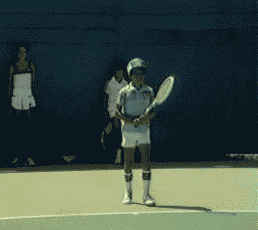this is a very touching summary of the vic braden
the man who changed tennis forever
a true lifelong tennis addict

grantland.com
learning tennis is the same as it was in 1977. absolutely nothing has changed. the only thing that has changed is A B C D has become 3.0 3.5 4.0 4.5
that's it.
take a lesson and try a new technique and be prepared to get worse for a while. this is why people never improve. they give up after 5 minutes of going backwards. new strokes will feel uncomfortable and unnautral, even if they are better.
braden is teaching a topspin game in 1977. the only thing different from 1977 to 2019 was that rec players thought "net skimmers" were the ideal shot. pros wanted more net clearance, but amateurs thought skimming the net was the ideal shot.
keep the ball deep was rule #1 in 1977
turn early was rule #3 in 1977
"keep your head down" was taught, but seeing the ball hit strings was already disproved in 1977.
Braden says most points end in 4 balls or less. Focus on serve+1. In 1977.
Moonballer was a term used in 1977...and people couldn't deal with junker styles back then either.
Give the opponent one more ball was rule #2 in 1977
To quote the book
"This is what the dinker does so well. Here is one more ball. Here is one more ball.
He keeps throwing up "moonballs" while you sit back there with all your fancy moves, cracking off net skimmers.
The dinker has never hit a hard ball in his life ... until you get so frustrated you try to end the point with a fancy shot,
which of course goes into the net.
No one likes to play dinkers because they drive you crazy.
Why don't you stand up and play like a man?
But, dinkers win for good reasons.
They have mastered several basic physical laws and psychological ploys
which make them winners in the Ds, Cs, Bs and 2 rounds of the As in almost every tennis club around the world.
You may make jokes about the dinkers, and they may have few friends, but their living room shelves are lined with trophies.
1977.
$5 to show you that nothing in tennis has changed in 100 years.
Vic Braden's Tennis for the Future [Braden, Vic; Bruns, Bill] on Amazon.com. *FREE* shipping on qualifying offers. Vic Braden's Tennis for the Future
www.amazon.com




